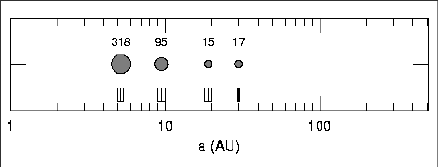
Animation: Click here for a quicktime movie of a portion of the temporal evolution of Run 12b. This animation is intended as a illustration of a global instability in our runs. At one point in the animation the temporal evolution is stopped and the system is rotated in order to show the inclinations generated during the run. The dotted circle has a radius of 5AU and is given as a reference for scale. This run is also shown in Figure 3 of the main text.
Animation: Click here for a quicktime movie of the temporal evolution of the stable system created in Run 7b. This system shows significant macroscopic changes, but is stable for at least a billion years. The solid ellipses represent the orbits of the 3 planets in the system. The shape and color of the ellipses represent eccentricity and inclination, respectively. If the color of the ellipse is white then the inclination is near zero. If it is dark, then the inclination of the orbit is near its maximum, which is approximately 40 degrees for the inner planet and 15 degrees for the outer two planets (see Figure 12 of the main paper). The dotted circle has a radius of 5AU and is given as a reference for scale.
Stable Systems: The following table of figures show the stable systems generated by our runs. The real solar system is also shown for reference. In each figure, the positions of circles along the abscissa indicates the planet's semi-major axis. The size of each circle indicate the planetary mass (radius goes as the cube root of mass). In addition, the mass of the planet, in Earth masses, is printed above each planet. The markings beneath each planet indicate the range of heliocentric distances with the central vertical line indicating the semi-major axis.
Click on a figure to download a table of the orbital elements for that system. The resulting text file is an ASCII table of the orbital elements. The columns of the table are: mass (Earth Masses), semi-major axis (AU), eccentricity, inclination, argument of perihelion, longitude of the ascending node, and mean anomaly. The angles are given in degrees.
